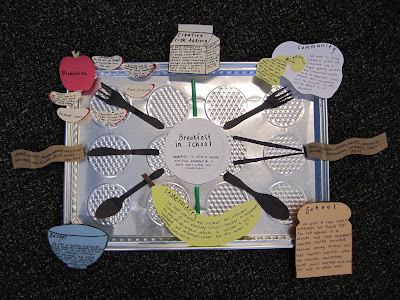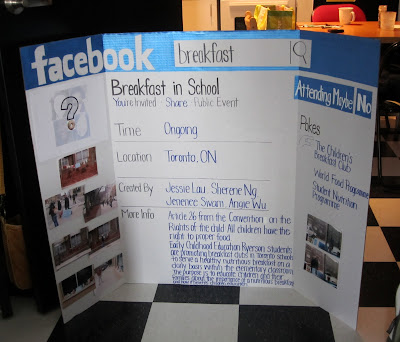Our 'BIG' Idea: Breakfast In Schools
Promoting breakfast clubs in Toronto Schools to serve a free, healthy nutritious breakfast on a daily basis within the elementary classroom.
Promoting breakfast clubs in Toronto Schools to serve a free, healthy nutritious breakfast on a daily basis within the elementary classroom.
Objective: To educate children and parents about the importance of a nutritious breakfast.
What do you believe in?
Article 26 from the Convention on the Rights of the child:
All children have the right to proper food.
I had the pleasure of working together with Jessie, Jenenee and Sherene to discuss and plan what we felt was an important issue to address. My group and I spent many long hours in the lounge of my apartment drawing, painting, cutting, gluing, stringing, taping - everything imaginable to get to the final product. It was a long, tiring process... but in the end I'm happy to say that I'm proud of our achievements and effort.
I think our presentation went really well. We followed the criteria of the assignment, and I think we were able to cover the main points of our vision, as well as small steps and strategies to achieving that BIG idea of ours. Our group used a lot of creative visuals, and we each had a good bulk of information we wanted to share with the class.
Things I would have done differently is to include a powerpoint with pictures of our Guerilla Art. I don't think people were able to see our 4x6 photographs that were taped onto our facebook board. Putting it onto a powerpoint just allows everyone to see our visuals from where they were seated. Secondly, I would have run through our presentation a few more times because unfortunatelly we ran out of time and had to cut it short. Although we did get our main message across, it would have been nice to be able to share everything that we had worked so hard to prepare for.
Surprisingly, we didn't have any comments, suggestions, or questions from the class feedback.
 |
| Breakfast Conceptual Map! |
 |
| Facebook Promotion |
Stakeholders:
- 2 Elementary School Teacher
- A nutritionist
- A restaurant owner
- Ad commerical
- Word of Mouth
- Guerilla Art
- Education in School (ie. sending newsletters home, teaching children about the importance of
breakfast through movies/clips, books and activities)
CAP Commercial
Links:
Citytv - The Children's Breakfast ClubToronto Realtor Launches School Breakfast Program
ART WORD OF THE WEEK:Tex·ture [teks-cher]
Texture "refers to the surface quality of a work of art" (Schirrmacher & Fox, 2009, p. 144). How does it feel? Does it feel hard or soft? rough or smooth? wet, sticky, or dry? rough or smooth? Different textures can provide different sensory stimulations to children which is a great way to sustain their interest. Early childhood educators can provide children with a variaty of textured matrials to play or use both in the classroom and outside on the playground. The element of texture can be furthered explored by children by allowing them to look for different textures in their environments.
I think we really poured our creative juices into this project. We used a whole range of materials of different textures to create our visuals - from cheerios, to styrofoam, straws, metallic paint, tin cookie tray etc. At one point, I ran out of a certain color of construction paper so I improvised and cut up a paper bag instead.
Schirrmacher, R., & Fox, J. E. (2009). Art & creative development for young children (6th ed.). Clifton Park, NY: Thomson/Delmar Learning.




















